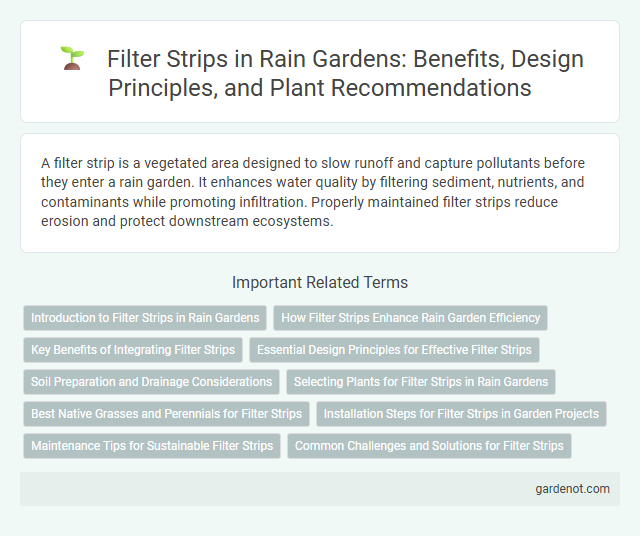A filter strip is a vegetated area designed to slow runoff and capture pollutants before they enter a rain garden. It enhances water quality by filtering sediment, nutrients, and contaminants while promoting infiltration. Properly maintained filter strips reduce erosion and protect downstream ecosystems.
Introduction to Filter Strips in Rain Gardens
Filter strips in rain gardens act as vegetated buffer zones designed to slow down runoff, trapping sediments and pollutants before they enter water bodies. These strips typically consist of dense grasses and plants that enhance infiltration and improve water quality by filtering contaminants. Properly designed filter strips reduce erosion and promote healthier urban stormwater management systems.
How Filter Strips Enhance Rain Garden Efficiency
Filter strips enhance rain garden efficiency by capturing and slowing runoff, allowing sediment and pollutants to settle before water enters the garden. These vegetated zones act as natural buffers, improving infiltration rates and reducing soil erosion. Effective integration of filter strips increases nutrient absorption, promoting healthier rain garden ecosystems.
Key Benefits of Integrating Filter Strips
Filter strips enhance rain garden performance by improving water infiltration and reducing surface runoff. These vegetative buffer zones trap sediments, nutrients, and pollutants, significantly improving water quality. Integrating filter strips also promotes soil stabilization and provides habitat for beneficial microorganisms, supporting ecosystem health.
Essential Design Principles for Effective Filter Strips
Filter strips must be designed with adequate width and slope to optimize stormwater infiltration and pollutant removal, typically ranging from 10 to 30 feet in width with a gentle slope below 5%. Vegetation selection is critical, favoring deep-rooted native grasses and dense herbaceous plants that enhance sediment capture and nutrient uptake. Proper soil composition with high permeability and organic matter content supports effective filtration, preventing surface runoff and promoting groundwater recharge.
Soil Preparation and Drainage Considerations
Proper soil preparation in a rain garden's filter strip involves loosening compacted soil and incorporating organic matter to enhance permeability and nutrient absorption. Ensuring adequate drainage requires grading the strip to direct runoff evenly across the surface while preventing water pooling that can lead to anaerobic conditions. Selecting well-draining soil with balanced texture supports effective filtration and promotes healthy plant growth within the rain garden system.
Selecting Plants for Filter Strips in Rain Gardens
Selecting plants for filter strips in rain gardens requires prioritizing native species with deep root systems that enhance soil infiltration and pollutant removal. Grasses, sedges, and wildflowers adapted to periodic flooding and drought improve water quality by trapping sediments and uptaking nutrients. Proper plant selection maximizes the filter strip's effectiveness in managing stormwater runoff while supporting local biodiversity.
Best Native Grasses and Perennials for Filter Strips
Best native grasses and perennials for filter strips in rain gardens include switchgrass (Panicum virgatum), little bluestem (Schizachyrium scoparium), and purple coneflower (Echinacea purpurea). These species excel at filtering stormwater runoff by trapping sediments and pollutants while promoting infiltration through deep root systems. Selecting drought-tolerant and regionally adapted plants enhances filter strip effectiveness and supports local biodiversity.
Installation Steps for Filter Strips in Garden Projects
Filter strip installation in garden projects begins by selecting a gentle slope area adjacent to the lawn or impermeable surface, ensuring 2% to 6% gradient for optimal water flow. Excavate soil to a depth of 6 to 12 inches, amending with organic compost to enhance infiltration and nutrient absorption. Finally, plant native grasses or groundcovers with deep root systems to stabilize soil and maximize pollutant filtration.
Maintenance Tips for Sustainable Filter Strips
Regularly removing debris and sediment buildup ensures optimal water infiltration and prevents clogging in filter strips. Periodic inspection and trimming of vegetation promote healthy plant growth, enhancing pollutant filtration capacity. Applying mulch annually helps retain soil moisture and suppress weeds, contributing to the long-term sustainability of rain gardens.
Common Challenges and Solutions for Filter Strips
Filter strips often face challenges such as soil compaction, poor vegetation establishment, and inadequate slope design, which reduce their effectiveness in pollutant removal and stormwater infiltration. Implementing appropriate soil amendments, selecting native deep-rooted plants, and ensuring a gentle slope between 2-6% can enhance filtration performance and prevent erosion. Regular maintenance like periodic mowing and sediment removal also helps sustain the filter strip's function and longevity.
Filter strip Infographic

 gardenot.com
gardenot.com